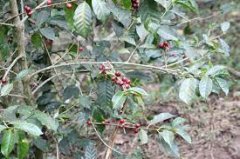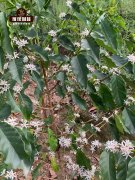What is a shaded coffee tree? What are the effects of the benefits of shaded coffee on the flavor characteristics of coffee beans
Coffee grown in the shade is grown under the canopy of tall trees, which provide shade. Traditionally, coffee has been grown in this way-under the canopy of natural forests-and there are many benefits if you do so. However, pressure to increase crop yields has led some coffee crops to be planted with less shade and / or direct sunlight, which requires greater use of pesticides and non-natural fertilizers.

There are several types of shade grown coffee, depending on the type and quantity of shade provided by shade trees.

Countryside: when using this method, native plants are rarely removed. This is the least invasive method in coffee cultivation, the least management, and no use of non-natural pest control.
Traditional mixed farming: this method is based on growing coffee crops and other intentional crops under native shade trees and other fauna. Compared with the rural approach, it involves more modification and removal of native plants and provides farmers with marketable coffee beans and other crops (fruits, vegetables, medicines, etc.) that can be used at home or sold on the market.
Commercial mixed culture: in terms of the types of crops grown (coffee and other useful plants), similar to traditional mixed culture, commercial mixed culture is different in that it involves the removal of leaves to make room for coffee crops. Shade trees are pruned and epiphytes (harmless creatures that live on other plants and provide diverse habitats for other creatures) are removed. This shaded coffee usually contains a certain level of fertilizers and pesticides, and the only vegetation layer is the canopy and coffee.
Shadow single cultivation: coffee crops are more intensive and more tightly managed. Only one or two kinds of trees-regularly pruned-provide shade for crops. Most of the native plants have been removed from this category to make room for coffee crops.
Shadowless monoculture (plenty of sunlight): coffee trees are directly exposed to the sun-there is no crown except for a few isolated trees. These plants require a high level of pest control, and native forests have been destroyed.
The benefits of shade coffee
It tastes good
Because shade coffee ripens more slowly, it usually provides a more complex taste and is more delicious than other coffees. In addition, coffee grown in shade can promote pollination of coffee and other nearby plants.
Protect the natural ecosystem
Shade-grown coffee plays a role in the natural ecosystem, contributing to and getting help. Shade trees provide a lot of nutrients for coffee plants and the surrounding soil, natural enemies help control coffee pests, and shade trees help protect coffee crops from frost.
Conservation of natural biodiversity
Migratory and tropical birds, reptiles, ants, butterflies and many other creatures and plants make their home in the canopy. This biodiversity has had a positive impact on the environment as a whole, beyond the canopy of locally grown coffee.
Protect local water supply
The roots of coffee plants help to intercept runoff and keep the local water supply clean and pure. Intercepting runoff also helps to prevent erosion. Coffee grown in shade requires less irrigation than coffee grown in the sun.
Maintain atmospheric balance
Coffee grown in the shade helps reduce deforestation by keeping trees standing, which helps maintain atmospheric balance due to carbon sequestration.
Important Notice :
前街咖啡 FrontStreet Coffee has moved to new addredd:
FrontStreet Coffee Address: 315,Donghua East Road,GuangZhou
Tel:020 38364473
- Prev

Introduction of El Salvador Neverland Coffee Variety Bourbon Coffee Bean flavor and taste hot
La Ilusin the average coffee tree on the farm is more than 20 years old and grows 95 per cent of bourbon (70 per cent red bourbon and 25 per cent orange bourbon). The remaining 5% is a combination of other varieties, and some tin trees and Kenyan trees may also be found. The farm is operated in an environmentally friendly way because farmers are trying to keep balance with the surrounding ecosystem, while Zhou
- Next

How do Iron pickup Coffee and Bourbon Coffee identify different Coffee varieties
You may or may not know what coffee trees look like, what iron pickup coffee trees look like, and what about the Bourbon dynasty. There are many kinds of coffee, but it is not always clear how they are different. Leaving aside the changes in flavor and outline, there are obvious physical differences between plants. Not to mention the different shapes of many coffee trees, just look at the coffee flowers in the coffee trees, because the varieties
Related
- Detailed explanation of Jadeite planting Land in Panamanian Jadeite Manor introduction to the grading system of Jadeite competitive bidding, Red bid, Green bid and Rose Summer
- Story of Coffee planting in Brenka region of Costa Rica Stonehenge Manor anaerobic heavy honey treatment of flavor mouth
- What's on the barrel of Blue Mountain Coffee beans?
- Can American coffee also pull flowers? How to use hot American style to pull out a good-looking pattern?
- Can you make a cold extract with coffee beans? What is the right proportion for cold-extracted coffee formula?
- Indonesian PWN Gold Mandrine Coffee Origin Features Flavor How to Chong? Mandolin coffee is American.
- A brief introduction to the flavor characteristics of Brazilian yellow bourbon coffee beans
- What is the effect of different water quality on the flavor of cold-extracted coffee? What kind of water is best for brewing coffee?
- Why do you think of Rose Summer whenever you mention Panamanian coffee?
- Introduction to the characteristics of authentic blue mountain coffee bean producing areas? What is the CIB Coffee Authority in Jamaica?

